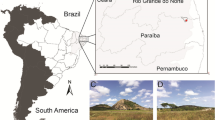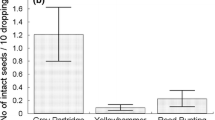Abstract
New Zealand is home to giant king crickets called weta, which are the only insects known to consume fleshy-fruits and disperse seeds after gut passage. Although they disperse seeds in viable condition after consumption, their importance as seed dispersers is unknown. We conducted a series of field observations and laboratory experiments to investigate intraspecific variation in the capacity of Wellington tree weta (Hemidenina crassidens) to disperse seeds of tree fuchsia (Fuchsia excorticata). We asked three questions. How frequently do weta disperse fuchsia seeds? Do seed passage rates differ between sexes and different-sized weta? Might weta select for particular seed sizes via differential seed mortality after ingestion? A total of 2,272 F. excorticata seedlings germinated from 241 scats (i.e., faecal pellets) that were collected from the field. Experimental results showed that, on average, 15% of seeds ingested by weta successfully germinated, whereas 75% germinated in control trials. Larger weta dispersed greater numbers of seeds in experimental trials, while no differences in dispersal rates were observed between sexes. Regardless of sex and size, weta preferentially dispersed larger seeds. When interpreted collectively, results indicate that (1) weta are frequent seed dispersers of F. excorticata, although many seeds are destroyed during ingestion, (2) larger-bodied weta consistently disperse greater quantities of seeds, which is unusual in seed dispersal mutualisms, and (3) weta preferentially disperse larger seeds, suggesting that they might interact evolutionarily with New Zealand plants.





Similar content being viewed by others
References
Amico G, Aizen MA (2000) Mistletoe seed dispersal by a marsupial. Nature 408:929–930
Blick R, Bartholomew R, Burrell T, Burns KC (2008) Successional dynamics after pest eradication in the Karori Wildlife Sanctuary. N Z Nat Sci 33:3–14
Bond WJ, Silander JA (2007) Springs and wire plants: anachronistic defences against Madagascar’s extinct elephant birds. Proc R Soc Lond Bi 274:1985–1992
Burns KC (2006a) A simple null model predicts fruit-frugivore interactions in a temperate rainforest. Oikos 115:427–432
Burns KC (2006b) Weta and the evolution of fleshy fruits in New Zealand. N Z J Ecol 30:405–406
Burns KC (2008) When is it coevolution? A reply to Morgan-Richards et al. N Z J Ecol 32:113–114
Burns KC (2009) Dietary diversity in fruit-eating birds: a biogeographic comparison between New Zealand and Canada. N Z J Ecol 33:52–59
Burns KC, Cazetta E, Galetti M, Valido A, Schaefer HM (2009) Geographic patterns in fruit colour diversity: do leaves constrain the colours of fleshy fruits? Oecologia 159:337–343
Carlo TA, Collazo JA, Groom MJ (2003) Avian fruit preferences across a Puerto Rican forested landscape: pattern consistency and implications for seed removal. Oecologia 134:119–131
Christian R, Kelly D, Turnbull MH (2006) The architecture of New Zealand’s divaricate shrubs in relation to light adaptation. N Z J Bot 44:171–186
Cook JM, Rasplus J-Y (2003) Mutualists with attitude: coevolving fig wasps and figs. Trends Ecol Evol 18:241–248
Dawson J (1988) Forest vines to snow tussocks: the story of New Zealand plants. Victoria University Press, Wellington
Duthie C, Gibbs G, Burns KC (2006) Seed dispersal by weta. Science 311:1575
Emeny MT, Powlesland RG, Henderson IM, Fordham RA (2009) Feeding ecology of kererū (Hemiphaga novaeseelandiae) in podocarp-hardwood forest, Whirinaki Forest Park, New Zealand. N Z J Ecol 33:114–124
Field LH (2001) The biology of ketas, king crickets and their allies. CAB International, Wallingford
Fischer KE, Chapman CA (1993) Frugivores and fruit syndromes: differences in patterns at the genus and species level. Oikos 66:472–482
Fuentes M (1995) How specialized are fruit-bird interactions? Overlap of frugivore assemblages within and between plant species. Oikos 74:324–330
Gautier-Hion A, Duplantier J-M, Quris R, Feer F, Sourd C, Decoux J-P, Dubost G, Emmons L, Erard C, Hecketsweiler P, Moungazi A, Roussilhon C, Thiollay J-M (1985) Fruit characters as a basis of fruit choice and seed dispersal in a tropical forest vertebrate community. Oecologia 65:324–337
Gibbs G (2001) The New Zealand weta. Reed, New Zealand
Herrera CM (1985) Determinants of plant-animal coevolution: the case of mutualistic dispersal of seeds by vertebrates. Oikos 44:132–144
Herrera CM (1998) Long-term dynamics of Mediterranean frugivorous birds and fleshy-fruits: a 12 year study. Ecol Monogr 68:511–538
Herrera CM (2002a) Seed dispersal by vertebrates. In: Herrera CM, Pellmry O (eds) Plant–animal interactions: an evolutionary approach. Blackwell, Oxford, pp 185–208
Herrera CM (2002b) Correlated evolution of fruit and leaf size in bird dispersed plants: species-level variance in fruit traits explained a little further? Oikos 97:426–432
Hollander JL, Vander Wall SB (2009) Dispersal syndromes in North American Ephedra. Int J Plant Sci 170:323–330
Jansen PA, Bongers F, van der meer PJ (2008) Is farther seed dispersal better? Spatial patterns of offspring mortality in three rainforest species with different dispersal abilities. Ecography 31:43–52
Janzen DH (1984) Dispersal of small seeds by big herbivores: foliage is the fruit. Am Nat 123:338–353
Jordano P (1987) Patterns of mutualistic interactions in pollination and seed dispersal: connectance, dependence asymmetries, and coevolution. Am Nat 129:657–677
Kelly D, Ladley JJ, Robertson AW, Anderson SH, Wotton DM, Wiser SK (2010) Mutualisms with the wreckage of an avifauna: the status of bird pollination and fruit dispersal in New Zealand. N Z J Ecol 34:66–85
Korine C, Kalko E, Herre E (2000) Fruit characteristics and factors affecting fruit removal in a Panamanian community of strangler figs. Oecologia 123:560–568
Levey DJ, Benkman CW (1999) Fruit-seed disperser interactions: timely insights from a long-term perspective. Trends Ecol Evol 14:41–43
Lomáscolo SB, Speranza P, Kimball RT (2008) Correlated evolution of fig size and color supports the dispersal syndromes hypothesis. Oecologia 156:783–796
Lord JM (2004) Frugivore gape size and the evolution of fruit size in southern hemisphere floras. Aust Ecol 29:430–436
Lord JM, Marshall J (2001) Correlations between growth form, habitat, and fruit colour in the New Zealand flora, with reference to frugivory by lizards. N Z J Bot 39:567–576
Moran C, Catterall CP, Green RJ, Olsen MF (2004) Functional variation among frugivorous birds: implications for rainforest seed dispersal in a fragmented subtropical landscape. Oecologia 141:584–595
Morgan-Richards M, Trewick SA, Dunavan S (2008) When is it coevolution? The case of ground wētā and fleshy fruits in New Zealand. N Z J Ecol 32:108–112
Olesen JM, Valido A (2003) Lizards as pollinators and seed dispersers: an island phenomenon. Trends Ecol Evol 18:177–181
Poulsen JR, Clark CJ, Connor EF, Smith TB (2002) Differential resource use by primates and hornbills: implications for seed dispersal. Ecology 83:228–240
Robertson AW, Trass A, Ladley JJ, Kelly D (2006) Assessing the benefits of frugivory for seed germination: the importance of the deinhibition effect. Funct Ecol 20:58–66
Robertson AW, Ladley JJ, Kelly D, McNutt KL, Peterson PG, Merrett MF, Karl BJ (2008) Assessing pollination and fruit dispersal in Fuchsia excorticata (Onagraceae). N Z J Bot 46:299–314
Sokal RR, Rohlf FJ (1995) Biometry. Freeman, New York
Spencer AM (1995) Sexual maturity in the male tree weta Hemideina crassidens (Orthoptera: Stenopelamatidae). MSc thesis, Victoria University of Wellington, New Zealand
Traveset A, Riera N (2005) Disruption of a plant-lizard seed dispersal system and its ecological effects on a threatened endemic plant in the Balearic Islands. Conserv Biol 19:421–431
Traveset A, Riera N, Mas RE (2001) Ecology of fruit-colour polymorphism in Myrtus communis and differential effects of birds and mammal on seed germination and seedling growth. J Ecol 89:749–760
Vander Wall S (1990) Food hoarding in animals. University of Chicago Press, Chicago
Wardle P (2002) Vegetation of New Zealand. Blackburn, New Jersey
Whelan CJ, Willson MF (1994) Fruit choice in migrating North American birds: field and aviary experiments. Oikos 71:137–151
Williams PA, Karl BJ, Bannister P, Lee WG (2000) Small mammals as potential seed dispersers in New Zealand. Aust Ecol 25:523–532
Wotton DM (2002) Effectiveness of the common gecko (Hoplodactylus maculatus) as a seed disperser on Mana Island, New Zealand. N Z J Bot 40:639–647
Zamora R (2000) Functional equivalence in plant-animal interactions: ecological and evolutionary consequences. Oikos 88:442–446
Acknowledgments
We would like to thank George Gibbs for advice and encouragement and for helping us collect study organisms. We are grateful to Alex Dixon for logistical help, the Karori Wildlife Sanctuary for allowing us to conduct the study and Victoria University of Wellington for financial support. We would also like to three anonymous reviewers for constructive criticisms on an earlier draft.
Author information
Authors and Affiliations
Corresponding author
Rights and permissions
About this article
Cite this article
King, P., Milicich, L. & Burns, K.C. Body size determines rates of seed dispersal by giant king crickets. Popul Ecol 53, 73–80 (2011). https://doi.org/10.1007/s10144-010-0222-9
Received:
Accepted:
Published:
Issue Date:
DOI: https://doi.org/10.1007/s10144-010-0222-9




